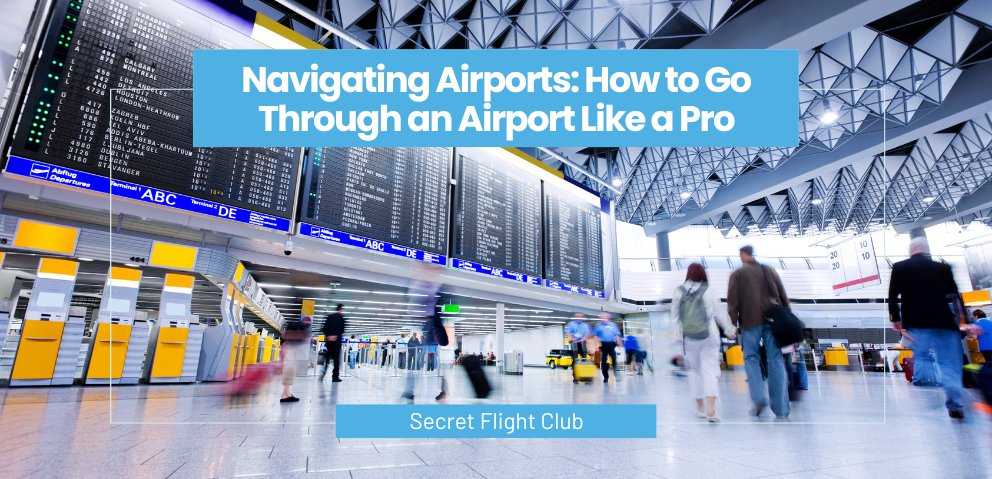Navigating Airports: How to Go Through an Airport Like a Pro
19 July 2024

Navigating the labyrinthine corridors of airports can often feel like a daunting endeavour, especially for those who find themselves pondering how to go through an airport efficiently. With the plethora of steps involved, from check-in to boarding, mastering the airport process is essential for a stress-free journey. Understanding the complexities of security screening, finding your gate number promptly, and making the most of your time at the airport are pivotal. Furthermore, for many, the question of how long does it take to go through an airport remains a significant pre-travel concern, underscoring the importance of effective airport navigation.
This article aims to provide a step-by-step guide on how to go through an airport, focusing on essential aspects such as planning ahead for a smooth journey, streamlining the check-in and security screening process, and offering tips for the boarding process. Additionally, insights on what to do at the airport during wait times to enhance your travel experience are included. Whether you're a first-time flyer wondering how to go through an airport for the first time or a seasoned traveller looking for airport hacks to expedite your journey, this comprehensive guide offers invaluable advice to navigate airports with the confidence of a pro.
Planning Ahead for a Smooth Journey
Researching Airport Layout
Before heading to the airport, it's crucial to familiarise oneself with the layout of the terminal. Knowing the location of key facilities such as restrooms, dining options, and lounges can significantly reduce stress and improve the overall airport experience. Digital maps with walking counts and estimated times to various points can be invaluable, especially for those navigating an unfamiliar airport or when managing additional challenges like travelling with a stroller. By understanding the layout, passengers can plan their route to remain within sight of their gate, reducing anxiety and ensuring they have ample time before boarding.
Checking Flight Updates
Staying informed about the status of one's flight is essential to avoid unexpected delays and make timely decisions. Travellers should utilise airline apps and websites to track real-time updates regarding their flight's status, gate changes, and boarding times. Tools like FlightAware and FlightRadar24 offer comprehensive flight tracking capabilities, providing updates on delays, cancellations, and even the inbound status of the plane. This information allows passengers to proactively seek alternative flights or adjust their plans accordingly, rather than waiting for announcements at the airport.
Preparing Entertainment
Long waits at the airport can be made more enjoyable by planning ahead for entertainment. Travellers should consider downloading movies, music, or podcasts to their devices to enjoy during downtime. Ensuring that electronic devices are fully charged and packing headphones are also advisable, as these can be used to watch films or listen to music without disturbing fellow passengers. Additionally, bringing a good book or engaging in online activities using the airport's Wi-Fi can provide a pleasant distraction from the often tedious waiting periods at the airport.
Streamlining Check-In and Security
Check-In Strategies
When preparing for a flight, it's crucial to streamline the check-in process to ensure a smooth transition through the airport. Travellers should consider checking in online to avoid long queues at the airport. This can be done via the airline’s website or mobile app, where they can also select seats and pay for any additional luggage. For those carrying only hand luggage, online check-in allows bypassing the check-in counters entirely, heading straight to security.
Security Tips
Security can often be the most time-consuming part of airport navigation. To expedite this process, passengers should familiarise themselves with TSA rules, such as the 3-1-1 liquids rule, and ensure all liquids and electronics are easily accessible in their carry-on luggage. Wearing appropriate clothing can also speed up the process; for example, shoes without laces and clothing without large metal buttons or belts are advisable. All metal items, including keys and coins, should be placed in a tray to avoid setting off metal detectors, which can cause delays.
Speeding Up the Process
Several programmes and strategies can help speed up the security process. Enrolling in TSA PreCheck is highly recommended, as it allows passengers to pass through security without removing shoes, laptops, liquids, belts, or light jackets. This can reduce waiting time significantly. Similarly, the Clear programme uses biometric data to confirm identity, allowing for even faster clearance through security checkpoints. For international travellers, Global Entry provides expedited processing through U.S. Customs and Border Protection. Additionally, choosing less busy travel times and dressing appropriately can further reduce time spent in security lines.
By implementing these strategies, travellers can navigate check-in and security with greater ease, making their journey through the airport as efficient as possible.
Making the Most of Wait Time
Airport Amenities
Airports are equipped with a variety of amenities designed to make the waiting time more comfortable and convenient. Passengers can freshen up using the facilities, which include toilets, showers, and water fountains located before and after security checkpoints. For those needing to stay connected, charging points are available throughout all terminals, ensuring devices remain powered up. Additionally, airports provide free trolleys in key areas to help with luggage transportation, and for smokers, designated smoking points are available.
For financial transactions or postal needs, ATMs accepting major international credit and debit cards are accessible, along with a variety of convenient postal services. Meeting rooms equipped with office facilities offer a professional space for business travellers. Moreover, for spiritual or personal reflexion, quiet retreats such as prayer and meditation rooms are open to everyone, regardless of faith.
Relaxation Spots
Finding a quiet space in a bustling airport is essential for many travellers. Airports like Heathrow and Frankfurt offer dedicated 'Rest and Relaxation Rooms' and 'Quiet Rooms' respectively, providing a calm atmosphere for passengers to unwind. The Quiet Zone by Gate 17 in Departures, specifically designed for passengers with disabilities like autism, offers a calming environment away from the crowd. Additionally, empty gates often present a quiet escape from the busy terminal areas, and dedicated yoga spaces are becoming more common for those looking to stretch or meditate.
Airport Lounges
While airport lounges are traditionally seen as a haven of comfort, recent evaluations suggest that the quality can vary significantly. Lounges like those operated by Aspire have seen a price increase, yet they may not always offer the space or amenities expected. However, decent lounges exist at airports such as Heathrow, Gatwick, and Manchester, where the experience can be worth the cost if a favourable deal is found. For a truly serene experience, lounges that are not overcrowded provide a peaceful retreat, and passengers should inquire about the current usage before entering to ensure a quiet environment.
To maximise the waiting time at airports, passengers should explore these amenities and relaxation spots, which are designed to enhance the overall travel experience, making the journey as stress-free as possible.
Boarding and In-Flight Tips
Boarding Process
Boarding a plane can often feel like organised chaos, especially for those not familiar with the process. To ensure a smooth boarding experience, passengers should be prepared with all necessary items. Personal items should be ready to go under the seat in front of them for easy access during the flight. Carry-on suitcases, ideally selected to fit one's style and meet airline regulations, should be stowed in the overhead bins. Boarding typically takes 15 to 45 minutes, starting 30 to 45 minutes before departure, with gates closing 10 to 15 minutes prior.
Passengers are boarded in groups, determined by ticket class, seat location, and loyalty status. To avoid delays, it is crucial to arrive at the gate early, have boarding passes and identification ready, and respect the boarding order. Ensuring items are well-organised and adhering to the specified boarding group can significantly streamline the process.
On-Board Comfort
Once seated, passengers can take steps to maximise their comfort during the flight. Choosing a seat early and considering the location, such as near the window for scenery or the aisle for easy restroom access, can enhance the experience. For long-haul flights, bringing a travel pillow, wearing comfortable clothing, and using noise-cancelling headphones can make a significant difference. Additionally, keeping hydrated and using moisturiser can help counteract the dry cabin air.
For those prone to leg swelling or discomfort, wearing compression socks and occasionally elevating the feet can improve circulation and comfort. Passengers should also be mindful of the limited space and ensure their carry-on does not overfill the overhead storage.
In-Flight Etiquette
Behaviour on board can greatly affect the experience of all passengers. Observing simple etiquette can ensure a pleasant journey for everyone. This includes using headphones for any media, keeping the volume down during conversations, and managing personal space by not overcrowding the overhead bins or armrests. Passengers should also be considerate by not reclining their seats during meals or when it can inconvenience others.
Helping fellow passengers with luggage and following crew instructions can contribute to a smoother flight. Additionally, being patient during boarding and disembarkation, respecting privacy and personal space, and maintaining cleanliness are all practises that uphold the comfort and dignity of travel for everyone involved.
Conclusion
Through the exploration of various strategies, from planning ahead to making the most of airport amenities and in-flight tips, this article has equipped readers with the essential knowledge to navigate airports with ease and efficiency. By highlighting the importance of preparing for the journey, adhering to security guidelines, and utilising the facilities airports offer during wait times, travellers can transform their airport experience from stress-inducing to stress-free. Emphasising the strategies for a smooth boarding process and maintaining on-board comfort further ensures that travellers are well-prepared to handle the complexities of flying.
The significance of such advice should not be understated, as it holds the potential to drastically improve the travel experience, making journeys more enjoyable and less daunting. By implementing these key insights, passengers can confidently approach their next flight, knowing they have the tools and knowledge to traverse airports like a pro. Consequently, as travellers become more adept at navigating airports, the collective efficiency and enjoyment of air travel can be significantly enhanced, paving the way for smoother and more pleasant journeys across the globe.
FAQs
1. How can I find my way around an airport with ease?
To navigate an airport smoothly, follow these tips: Firstly, locate your gate before exploring any shops or eateries. Keep an eye on the flight information screens for any updates. Ensure you are at your gate in time for boarding rather than the scheduled departure time. Don't hesitate to ask for help or directions if you're unsure.
2. What are the key steps for going through an airport?
When departing, the airport process from start to finish includes:
- STEP 1: If you've checked in online, you can skip the check-in desk.
- STEP 2: Check in your luggage.
- STEP 3: Proceed through the security checkpoint.
- STEP 4: Go through immigration.
- STEP 5: Board the plane and later disembark.
- STEP 6: Pass through immigration again at your destination.
- STEP 7: Collect your baggage.
3. What are some tips for getting through TSA checks efficiently?
To pass through TSA checks like an expert, dress smartly by avoiding metal on clothing and shoes, and be prepared to remove your belt if it has a metal buckle. Place any large metal jewellery, coins, and keys into your carry-on or a plastic bin at the checkpoint to streamline your screening.
4. How can I travel on a plane like an experienced traveller?
For a professional travel experience, consider the following advice from a flight attendant:
- Pack effectively and ensure your bags are traceable.
- Allow sufficient time for your journey.
- Bring a reusable water bottle and snacks.
- Dress appropriately for your travel needs.
- Use noise-cancelling headphones.
- Take along some form of entertainment.
- Maintain personal hygiene and health during your flight.

